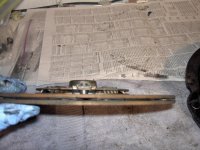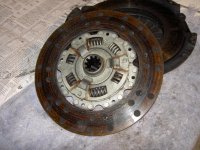Hello,
I just pulled the 4-speed on my '70 2800 in order to replace a leaky front seal. Since the incremental work was minimal, I proceeded to pull the clutch disc in order to diagnose a 1st gear "chatter" or slippage. The car exhibits this starting out, but never slips in higher gears. The clutch engages only at the very top of pedal travel, but disengages around mid-pedal-travel. It has only 39K on the clock, and there's no evidence the clutch/p-plate have been replaced.
Two of my clutch disc images are attached below. After pulling the F&S disc I measured it against the factory specs (wear & runout). It passed with a .36" thk and .008" runout. However, I could easily compress the outer and inner friction plates by .04". That is, when I pinch the disc it readily compresses, as if the rivets have stretched. The specs allow for this .04" compression but only under a 600 kg load. No cracks apparent / springs intact. There was no oil from the leaky tranny on the disc.
The pressure plate has no apparent flaws. However, when placing a ruler across its surface I can see minor gaps in spots. Factory manual says it must be perfectly flat, but I couldn't find a tolerance on this "flatness."
Finally, my exposed flywheel has cocentric ridges near the outer circumference. It too showed small gaps with a ruler pressed against it. Oddly, the ridges cover only half of the clutch disc's mating area.
So the questions:
1. What's the spec for acceptable clutch disc and flywheel "flatness"? My micrometer is too small to measure thicknesses near the center of said parts.
2. What caused the ridges in only part of the flywheel’s mating surface (out of curiosity)?
3. For the clutch chatter issue, is the root cause the flywheel ridges, the clutch disc "compressibility," or both?
4. I figure the flywheel should be skimmed, but is the clutch disc shot?
Looking forward to some discussion. Thanks, -H
I just pulled the 4-speed on my '70 2800 in order to replace a leaky front seal. Since the incremental work was minimal, I proceeded to pull the clutch disc in order to diagnose a 1st gear "chatter" or slippage. The car exhibits this starting out, but never slips in higher gears. The clutch engages only at the very top of pedal travel, but disengages around mid-pedal-travel. It has only 39K on the clock, and there's no evidence the clutch/p-plate have been replaced.
Two of my clutch disc images are attached below. After pulling the F&S disc I measured it against the factory specs (wear & runout). It passed with a .36" thk and .008" runout. However, I could easily compress the outer and inner friction plates by .04". That is, when I pinch the disc it readily compresses, as if the rivets have stretched. The specs allow for this .04" compression but only under a 600 kg load. No cracks apparent / springs intact. There was no oil from the leaky tranny on the disc.
The pressure plate has no apparent flaws. However, when placing a ruler across its surface I can see minor gaps in spots. Factory manual says it must be perfectly flat, but I couldn't find a tolerance on this "flatness."
Finally, my exposed flywheel has cocentric ridges near the outer circumference. It too showed small gaps with a ruler pressed against it. Oddly, the ridges cover only half of the clutch disc's mating area.
So the questions:
1. What's the spec for acceptable clutch disc and flywheel "flatness"? My micrometer is too small to measure thicknesses near the center of said parts.
2. What caused the ridges in only part of the flywheel’s mating surface (out of curiosity)?
3. For the clutch chatter issue, is the root cause the flywheel ridges, the clutch disc "compressibility," or both?
4. I figure the flywheel should be skimmed, but is the clutch disc shot?
Looking forward to some discussion. Thanks, -H


